Bulgarian pepper "Merchant": the advantages and disadvantages of the variety, the nuances of cultivation for a rich harvest
Bell peppers hold the record for the content of ascorbic acid and B vitamins. Fruits contain potassium, phosphorus, magnesium and other trace elements necessary for humans. Vegetables have a positive effect on the cardiovascular and digestive systems of the body.
The culture itself is thermophilic and capricious in care, but the breeders brought out the standard Kupets variety, which grows in almost all climatic zones, is unpretentious and gives a good harvest.
The content of the article
Description of the variety
Pepper was bred in 1998 especially for regions with unfavorable climates. It quickly adapted and gained wide popularity among farmers throughout Russia and other countries.
Main characteristics
The culture is grown in greenhouses, open ground and even on a windowsill... Strong, spreading bushes grow up to 90 cm in height, resembling dwarf trees. Dense foliage forms a lush crown with drooping stalks.
The stem and branches are thick and dense, withstand ripe vegetables well and do not need to be tied. The variety is early ripening: the period of fruit ripening from planting to technical maturity is 100-115 days.
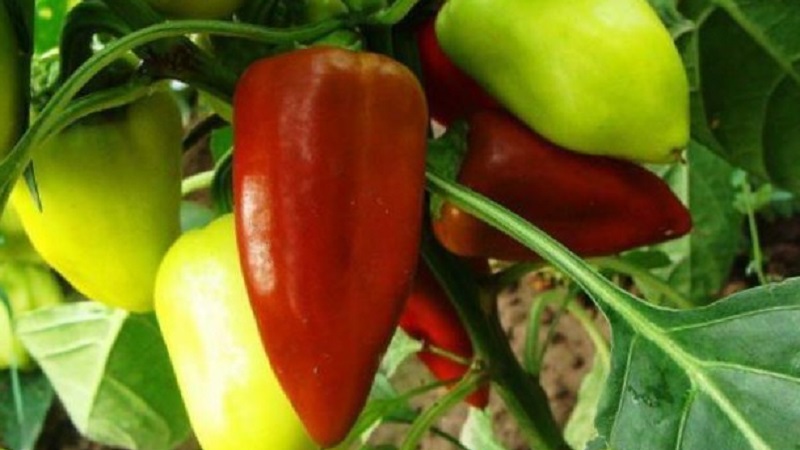
Distinctive features
The main distinguishing feature of the Merchant bell pepper is resistance to low temperatures and drought... The variety feels great both in the harsh Siberian climate and in the hot conditions of the southern regions. He is unpretentious in care.
Characteristics of fruits, yield
The fruits ripen large pyramidal. Average pepper mass - 100 g... In the state of technical maturity, vegetables are green, biological - red. The pulp is thick, 4–8 mm wide, sweetish juicy on the palate, without bitterness.
With good care, high air temperature and abundant watering The merchant gives up to 10 kg from 1 m2, but even in cold summer you can collect 3-4 kg from 1 m2 plot.
Important! Pepper is more resistant to transportation during the period of technical ripeness, at the same time the shelf life of the fruit also increases.
Preparation for growing
Seeds are not planted directly on the beds, otherwise they will not have time to ripen before the onset of cold weather. Soil for seedlings is bought in specialized stores or made on their own from ordinary earth, peat or sand, humus (1: 1: 1) and a handful of ash. The components are mixed, kneading the lumps, and the mixture is calcined in the oven for 2 hours at +200 ° C for disinfection.
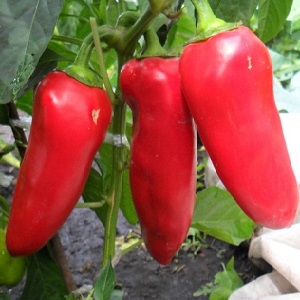 For planting, use containers with drainage holes at the bottom... Sowing begins in February, so that by May the seedlings are ready to be dived into the ground.
For planting, use containers with drainage holes at the bottom... Sowing begins in February, so that by May the seedlings are ready to be dived into the ground.
First seeds are sorted, choosing large and dense (they will give the best germination).
The best way to test planting material - put it in a glass of saline (for 200 ml of water, 10 g of salt). The floating seeds are removed, the ones that have sunk to the bottom are used. To protect future plants from fungi and infections, the grains are treated with a weak solution of potassium permanganate.
Other varieties of peppers:
Hybrid pepper "Atlant" and how it can surprise you
Growing seedlings
Before planting in the ground, the seeds are soaked for 2-3 days.... As soon as sprouts appear, they are planted in the soil to a depth of no more than 1 cm, covered with earth and watered.The containers are covered with cellophane wrap and placed in a warm, illuminated place (temperature - not lower than +24 ° C) until the first shoots hatch.
After the formation of 2-3 leaves, the seedlings are distributed in separate peat or plastic pots. Bell peppers do not like picking and may stop growing for a while. Therefore, it is better to immediately plant the germinated seeds in individual containers for 300-400 g. First, they deepen 3 grains in one pot, and when they germinate, they leave the largest and strongest shoot, the rest are pinched.
Seedlings provide maximum illumination for 11-12 hours and regular watering with warm water.
For hardening plants they are periodically taken out to a cooler place with a temperature of + 15 ... + 17 ° C.
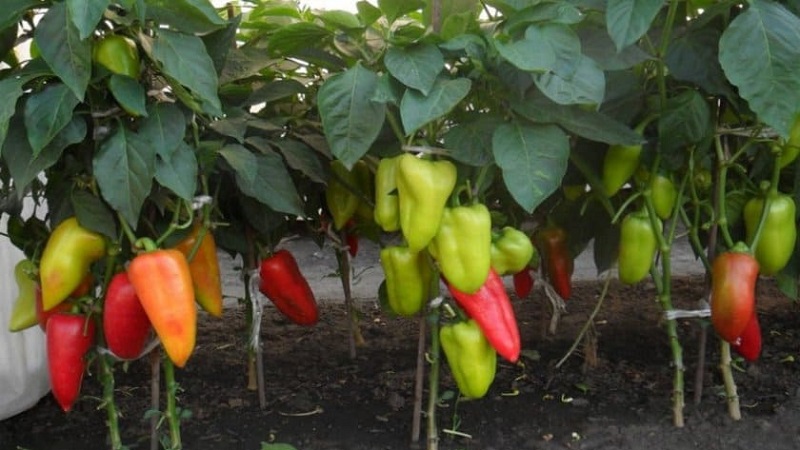
Planting pepper
In central Russia, peppers are transplanted into open ground not earlier than mid-May in consistently warm weather, when there is no threat of frost. They are planted in a film greenhouse in mid-April. Before picking, a little humus is added to the holes to feed the plants. 1 m2 have 4 sprouts.
The depth of the holes is made no more than the depth of the pots, in which the seedlings were located, because the culture does not develop a powerful root system. After that, the bushes are fed with mineral fertilizers for better adaptation to new conditions and watered abundantly.
Important! After planting the plants, the soil is not loosened for 2 weeks: during this period, the root system is strengthened.
Further care
The Kupets variety loves moisture. Water it in the evening right under the bush... When a shoot appears from the first fork, it is pinched so that the main stem does not stretch up, but lateral shoots grow and yield increases.
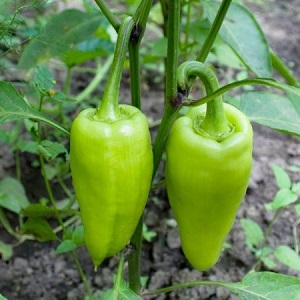 The longest shoots are pruned during the growing season and remove all branches below the first fork. Gardeners remove the first flower from the main branch to increase yields.
The longest shoots are pruned during the growing season and remove all branches below the first fork. Gardeners remove the first flower from the main branch to increase yields.
Good results during the flowering period give top dressing with organic fertilizers. This will attract pollinating insects to the plants.
The soil is loosened and hilled in a timely manner, weeds are removed.
After the appearance of the first ovaries the bushes are watered with phosphorus-potassium fertilizers. For the entire period of growth, this is done 2-3 times.
Attention! If the soil is oversaturated with nutrients before the fruits ripen, then all the juices will go to the growth of the stem and leaves.
Features of cultivation and possible difficulties
Pepper Merchant is unpretentious in care and adapts well to adverse climatic conditions... However, in dry soil, the development of seedlings slows down, so they are watered moderately, but regularly. At low air temperatures, excess moisture will be harmful - the plant will die.
Read also:
Pepper "Swallow": a description of the variety, its pros and cons
Typical diseases and pests
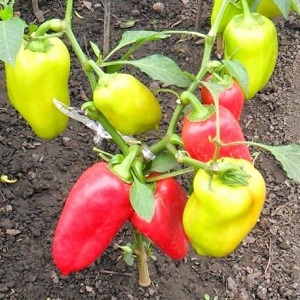 Merchant has good immunity to tobacco mosaic, top rot, resistant to verticillary wilt.
Merchant has good immunity to tobacco mosaic, top rot, resistant to verticillary wilt.
Pepper is susceptible to diseases associated with improper care... With a lack of phosphorus, the color of the leaves at the bottom turns purple. If there is a lot of nitrogen in the soil, flowers and ovaries will fall off. Drying of leaves occurs due to abundant watering with potash fertilizers. During heavy rains, the fruit may become gray. In this case, the bushes are sprayed with fungicides.
Insect pests can reduce yields by 70% and destroy all plantings... The most dangerous are aphids, Colorado beetles, bears, slugs. To combat them and prevent them using "Basamil", "Mycoafidin", "Fitosporin" and "Metarizin". Bushes are treated with insecticides every 2 weeks until the signs of harmful insects disappear completely.
Attention! After using chemicals, the fruit is consumed in 20-30 days.
Advantages and disadvantages of the variety
The merchant gained popularity among vegetable growers due to its advantages:
- perfectly tolerates cold and heat;
- ripens early;
- gives a high yield;
- large-fruited and tasty;
- resistant to major diseases.
The relative disadvantages of the variety include a large number of fruits on one bush - in such cases, a garter is required.
Reviews
The merchant conquered vegetable growers with his unpretentiousness, high productivity and fruit taste.
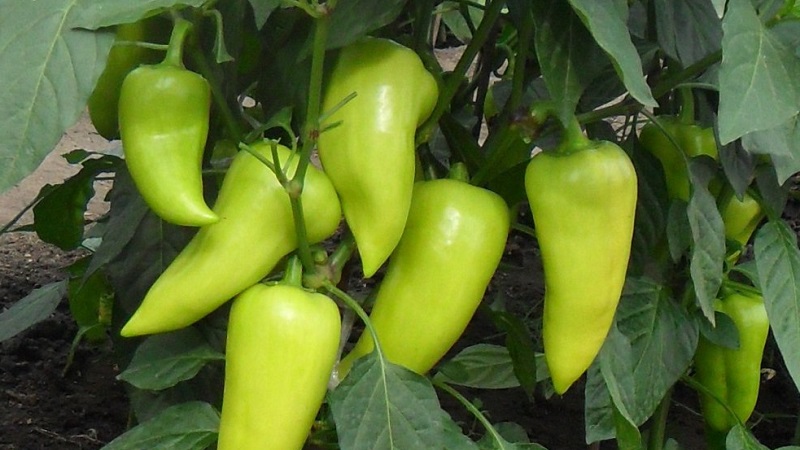
Victor, Kemerovo: “I used to think that bell peppers are not for Siberia. I planted the seeds of the Merchant and was pleasantly surprised when the pepper not only withstood our harsh climate, but also gave a good harvest ".
Lydia, Ryazan: "Very pleasant taste of the fruit, the variety is unpretentious in cultivation, and most importantly - it ripens very early and does not get sick".
Dmitry, Lower Volga region: “For our region with dry summer, the Kupets variety is just a godsend. With minimal costs and without much hassle, we get consistently high yields every year ".
Conclusion
The bell pepper variety Kupets was bred specifically for the short and cold summer in the regions of Siberia and the Urals, but in regions with hot climates it is also popular.
The culture is early maturing and resistant to major diseases. Observing simple conditions for planting, watering and fertilizing, farmers get a large harvest of tasty and healthy vegetables from a small plot of land.